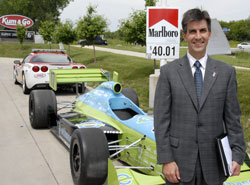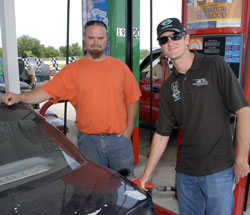 A group of students in West Virginia are learning how to brew up biodiesel, while helping run the buses to get them to those classes.
A group of students in West Virginia are learning how to brew up biodiesel, while helping run the buses to get them to those classes.
This story from the The State Journal says in the face of $5-a-gallon diesel fuel… and the likelihood of that growing to $6… the Lincoln County High School FFA has started the first biodiesel production center at a public school in the state:
Looking a little like the makings of a mad scientist’s laboratory with its large tanks and rubber tubes, the students’ equipment has the capacity of producing 400 gallons of biodiesel a week at a cost of about $1 per gallon.
The fuel will be used to power a school bus, saving the school district an estimated $32,000 its first year alone. But more importantly, it will give Lincoln County students a jumpstart in a technology that may turn out to be very profitable in the near future.
 “It opens the door to a whole new world,” Lincoln County FFA president Katelyn Brogan, 17, said. “You learn so much more from it: How to recycle properly, how to renew your fuels, how to save money and time.”
“It opens the door to a whole new world,” Lincoln County FFA president Katelyn Brogan, 17, said. “You learn so much more from it: How to recycle properly, how to renew your fuels, how to save money and time.”
Brogan isn’t planning on going into the biofuels industry after graduation; instead she wants to study forensics. But she said the group’s work with biodiesel is laying the foundation for biofuel training at the school.
“We are trying to prepare our students earlier and sooner … so they won’t go straight into college and go ‘Oh my gosh, I have no idea what I’m doing,'” she said.
The article goes on to say that the school received money from West Virginia’s Departments of Education and Agriculture to help purchase the $20,000 biodiesel refiner.
You can also check out the Lincoln County High School’s FFA’s web site and blog at www.lincolnffa.com.
 I finally got to meet the Team Ethanol driver, Ryan Hunter-Reay. Ryan was on hand at the Kum & Go pump promotion and posed here with the Highway Patrolmen who helped us with security and traffic and other drivers. He’s the tall guy on the left.
I finally got to meet the Team Ethanol driver, Ryan Hunter-Reay. Ryan was on hand at the Kum & Go pump promotion and posed here with the Highway Patrolmen who helped us with security and traffic and other drivers. He’s the tall guy on the left.

 There were several IndyCar drivers on hand at the Kum & Go ethanol pump promotion in Ankeny, IA. One of them was Ed Carpenter,
There were several IndyCar drivers on hand at the Kum & Go ethanol pump promotion in Ankeny, IA. One of them was Ed Carpenter,  The Senior Vice President of Marketing for
The Senior Vice President of Marketing for 

 “All three of us have a roll to play in this industry,” Nuernberg says. “We are looking at all the initiatives under way by the different organizations, how we can work together, and make sure we’re not duplicating effort.”
“All three of us have a roll to play in this industry,” Nuernberg says. “We are looking at all the initiatives under way by the different organizations, how we can work together, and make sure we’re not duplicating effort.” EPIC’s main focus is to drive demand with consumers, while RFA’s role is to protect and promote policy in Washington DC, and ACE is the grassroots organization dedicated to expansion of ethanol production.
EPIC’s main focus is to drive demand with consumers, while RFA’s role is to protect and promote policy in Washington DC, and ACE is the grassroots organization dedicated to expansion of ethanol production. A group of students in West Virginia are learning how to brew up biodiesel, while helping run the buses to get them to those classes.
A group of students in West Virginia are learning how to brew up biodiesel, while helping run the buses to get them to those classes. “It opens the door to a whole new world,” Lincoln County FFA president Katelyn Brogan, 17, said. “You learn so much more from it: How to recycle properly, how to renew your fuels, how to save money and time.”
“It opens the door to a whole new world,” Lincoln County FFA president Katelyn Brogan, 17, said. “You learn so much more from it: How to recycle properly, how to renew your fuels, how to save money and time.” The National Biodiesel Board has two new members on its Governing Board.
The National Biodiesel Board has two new members on its Governing Board. Hopkins, CEO of US Biofuels, has 35 years of combined experience in the biodiesel and chemical engineering fields, and is involved in several chemical production associations. US Biofuels, a multi-feedstock biodiesel producer, is based in Rome, Ga.
Hopkins, CEO of US Biofuels, has 35 years of combined experience in the biodiesel and chemical engineering fields, and is involved in several chemical production associations. US Biofuels, a multi-feedstock biodiesel producer, is based in Rome, Ga. Johnson, president & CEO of GEN-X, has had extensive experience in the food processing industry in capacities ranging from operations to quality assurance. GEN-X is a multi-feedstock producer based in Burbank, Wash.
Johnson, president & CEO of GEN-X, has had extensive experience in the food processing industry in capacities ranging from operations to quality assurance. GEN-X is a multi-feedstock producer based in Burbank, Wash. Consumers in Ankeny, IA were treated to a little relief at the gas pump today when the Ethanol Promotion and Information Council teamed up with Kum & Go for a pre-race ethanol promotion.
Consumers in Ankeny, IA were treated to a little relief at the gas pump today when the Ethanol Promotion and Information Council teamed up with Kum & Go for a pre-race ethanol promotion. General Electric has released a study that says the taxes paid back to the U.S. government are more than the tax incentives given to wind energy companies by the government.
General Electric has released a study that says the taxes paid back to the U.S. government are more than the tax incentives given to wind energy companies by the government.